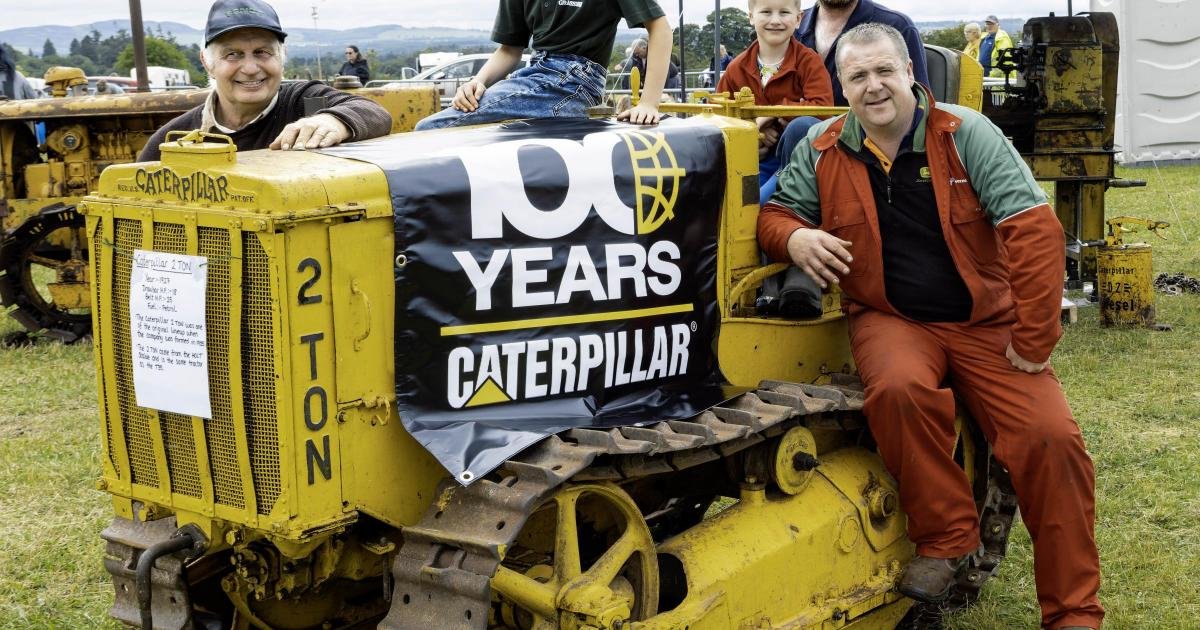But delve into its roots and you’ll find a company deeply embedded in the agricultural world – and still celebrated there today, even in the hills of Perthshire, where vintage machines continue to turn heads and till fields.
At this year’s Alyth Show, a remarkable display marked the centenary of Caterpillar – 14 vintage crawler tractors were carefully collected, restored and presented by a small group of enthusiasts, with none more passionate than Greg Wilkinson, a farmer and tractor man from Blairgowrie.
Greg, who works at Mains of Mause under Peter Alexander, has long held a deep affection for the Caterpillar D2, a small crawler tractor that once graced nearly every farm in the area.
“It was the D2 that started me among vintage tractors,” he says. “The tractor that I brought to the show was Ian Powrie’s (the famous fiddler) at Dupplin Farm when he was a young lad.
“He bought that tractor and restored it across the road from us. I always remembered it getting done up. When it was finished, I used to get to go out and get a hurl on it when I was little.”
The fascination stayed with him. Years later, when he began collecting old tractors, it was the D2 that remained elusive but desirable.
“I naturally looked for a D2. I really wanted that one. I couldn’t find it at the time. Eventually I found it about four years ago. It took a long time but I found it and bought it.”
Greg now owns three D2s, and for the 100th anniversary of Caterpillar, he helped coordinate the display of 15 crawlers at the Alyth Show.
“We raked up another five or six to take to the show. They hadn’t been out for a long, long time. We got them going and picked them up and took them out for various people.”

From wheat fields to war machines
The Caterpillar story begins far from Blairgowrie, in the sun-baked plains of California. In the late 19th century, Benjamin Holt and Daniel Best were separately developing mechanised solutions for harvesting wheat on the undulating terrain of the western United States. Best introduced steam-powered combined harvesters in the 1880s, while Holt would go on to build the first self-propelled, gas-powered combine in 1910.
Both men also explored track-laying tractors to deal with soggy or hilly terrain – machines that could replace the 40-mule teams once required for heavy work. Their early crawlers were steered with tiller wheels and, by the early 20th century, had become serious contenders on the farm and battlefield alike.
During the Second World War, Caterpillar tractors played a vital role in military engineering, clearing roads, building airstrips, and hauling supplies in tough terrain. Their reliability under fire helped cement the company’s reputation for rugged, dependable machines.
Many of these tractors reached the UK through the Lend-Lease program, a crucial wartime arrangement where the United States supplied Allied nations with military equipment and vehicles. This system ensured that vital machinery like Caterpillar crawlers could support the war effort across the Atlantic.
But innovation gave way to intense legal battles, with millions spent on patent disputes. Eventually, after years of rivalry and struggle, their two companies merged in 1925 to form Caterpillar Tractor Co – a name that came from a Holt photographer who remarked that the machine’s movement looked like a ‘caterpillar’ through the lens of his inverted camera.
D2: The people’s crawler
The D2 was introduced in 1938 as one of Caterpillar’s smallest diesel-powered crawlers. Compact yet powerful, it quickly found a home on farms across the UK and beyond. In Perthshire, these yellow machines became a fixture on almost every farm.
“Every farm in our area had a D2 Caterpillar at one time,” Greg says. “They were very popular. Although now the tracks and the weight mean they’re not the easiest thing to shift about. It’s amazing how many of them are still lurking in the corners of sheds.”
Today, they still impress.
“They’re only 47 horse. But the power they’ve got. The grip. The way they mark the ground. It’ll outweigh any modern four-wheel-drive tractor. They’re quite an amazing tractor really.”
Greg’s own D2 came with its original four-furrow plough from Dupplin Farm, and they’ve never been separated.
“That plough and tractor were supplied brand new. When you plough with them now, it’s modern-day on-land ploughing. The Caterpillar doesn’t run in the hole, it runs on the land and stacks up on the top. They were thinking about compaction even back then.”
An engineer’s marvel
One of the features that sets the D2 apart is its ‘donkey engine’ – a small petrol starter motor used to preheat and pressurise the diesel engine.
“The donkey engine – you start it, pre-pressure, it runs your oil pressure. It preheats the engine. Preheats the water through the manifold. It’s very clever. It obviously gets all your oil up to pressure. Then when you apply the handles to start the main engine, everything is up to scratch, ready to go.”
This kind of mechanical ingenuity is part of the allure. Greg and his friend Mark, another local collector, share stories, swap parts, and – more importantly – get their machines dirty.
“We’ve ploughed with one of the ones that was at the show with the big four-furrow plough on it. I’ve ploughed with it. Mark’s ploughed with it. We’ve rolled the ground with them as well. They’re good. We’ve had a lot of fun with them.”
Fortunately, Greg’s employer supports the hobby too.
“I’m lucky. Peter enjoys seeing the old tractors out. He doesn’t bother if we take them out to the fields. We have a bit of fun with them.”

Tracks through time
Despite their size and smoke, these machines tell a very human story, of long hours, physical toil, and innovation born of necessity.
“I think it’s important to remember all the work the old boys did when they were young,” Greg reflects. “You think of rolling a field in the summer, you’d be absolutely covered in dust, listening to the clatter below. It’s an important part of heritage. People need to understand just how hard it was.”
The world may now know Caterpillar as a global industrial titan, its name emblazoned on excavators, bulldozers, and even boots.
But thanks to people like Greg, we’re reminded that these machines once shaped the countryside and the communities who worked it.
And as 100 years of Caterpillar are celebrated globally, in one corner of Scotland at least, they’re not in a museum – they’re back in the field, crawling steadily along, just as they always did.








